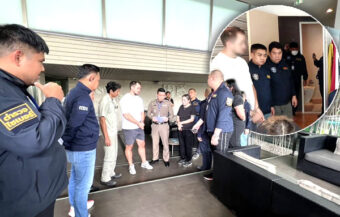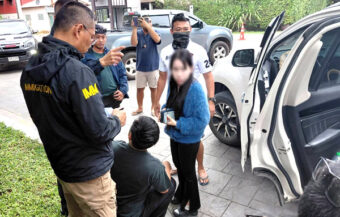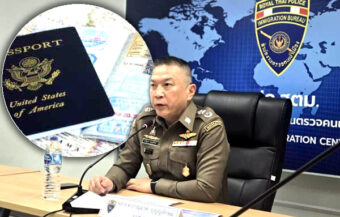Woman rescued after 32 hours with laboured breath and bleeding gums following a deadly krait bite as Hat Yai’s ‘Water of Death’ swells, blocking rescuers, stranding families, crippling supplies and triggering widespread flood alerts across southern Thailand.
As the death toll from the severe floods rises, horror stories are emerging from people pulled from the deluge that many in Hat Yai now call the ‘Water of Death.’ Grim accounts of survival and loss continue to surface. One case on Wednesday involved a woman in Hat Yai who went online at 3 a.m. pleading for help after a bite from a lethal krait snake. She endured the bite for 24 hours before issuing the emergency call. She was rescued eight hours later. Her breathing was laboured, and blood leaked from her teeth. Afterwards, she was given serum at a local hospital. Meanwhile, as water recedes in Hat Yai, levels are rising in Narathiwat.

Floodwaters in Hat Yai slowed rescue efforts on Wednesday, November 26, 2015, as conditions shifted across the district. The situation gained wide attention after a woman reported that a krait snake had bitten her while she was trapped in rising water for more than a day.
She posted repeated pleas for help on Facebook as flood levels blocked access to her home and prevented multiple agencies from reaching her. She said she and her boyfriend called more than ten agencies after 3 a.m., yet no team arrived until late morning. Her account circulated quickly and drew immediate public attention.
However, her condition worsened as she waited. She wrote that her gums were bleeding, her saliva was bloody, and her breathing was fast. She added that her legs felt swollen and painful.
Rescue of stranded mother as worsening symptoms intensify her urgent calls for medical help
She stated that she had been forced to move by boat and jet ski due to the flooding. She said she tried to stay calm in front of her child during the wait. She said she had to smile when turning toward her child. She said she could not die because her child was still young.
Eventually, officials reached her before noon and evacuated her. They transported her to Songkhla Hospital. She received serum shortly after arrival. She said doctors were monitoring her blood every four to six hours and checking the bite wound.
She thanked those who supported her online. Her posts triggered thousands of comments and messages. Many users shared her call to speed up rescue work.
Meanwhile, floodwaters across Hat Yai continued to shift. In several areas, water levels began to recede. However, strong currents remained in many zones. These currents prevented rescue teams from entering tight alleys or low areas where water stayed high. Officials warned that operations required extreme caution. They said traffic improved slightly on some main roads. They added that the overall situation needed close monitoring throughout the day.
Receding water exposes dangerous currents that hinder access and force rescue teams into caution
At the Kho Hong intersection, water fell enough to allow small vehicles to pass. The location sits at the junction of Kanchanawanit Road and Phetkasem Road, a major link in Hat Yai.
Soldiers from the 5th Infantry Regiment joined rescue units at a command point near the intersection. Teams from the Poh Teck Tung Foundation, the Surat Thani Provincial Administrative Organisation, and several volunteer groups also deployed there. They used forklifts, flat-bottomed boats, and jet skis to reach vulnerable groups.
They moved elderly residents, bedridden patients, and others to Prince of Songkla University. They also delivered food and drinking water to people stuck in high-rise buildings.
On Phetkasem Road, from the Kho Hong intersection to the zone in front of Big C Extra and Hat Yai Wittayalai School, water receded further. Boats could pass through more easily.
However, access near the fountain roundabout, Hat Yai Hospital, the Songkhla NBT Post Office intersection, and Hat Yai Railway Station remained blocked. Currents there stayed strong. Officials ordered boats to avoid the area. They said conditions were unsafe. As a result, the 42nd Military Circle deployed a helicopter. The aircraft dropped food and essential supplies to patients and medical staff trapped at Hat Yai Hospital.
Severe shortages of essentials deepen crisis as stranded residents and rescuers face danger
Additionally, volunteers reported critical shortages of drinking water and food. They said many neighbourhoods requested help at the same time. They identified the zone before the District 8 train station as especially urgent.
Many people there remained stranded. They asked for assistance in large numbers. Volunteers evaluated bringing in more water tankers. However, they moved carefully due to strong currents. Officials instructed residents to wave to rescue crews whenever possible so teams could pinpoint their locations.
Rescue workers near the Diana area on Sriphuwanat Road reported deep water and strong currents. They said many people had been evacuated. Yet obstructions under the water continued to slow operations.
They said parked cars below the surface damaged boat propellers. They described this flood as one of the worst they had seen in the district. They noted that they had worked in these areas many times. They said this year’s flooding surpassed earlier events.
Large-scale food operations struggle with supply gaps as communications failures overwhelm rescue teams
At Wat Kok Nao, the Poh Teck Tung Foundation opened a special operations unit and royal kitchen. The group prepared meals for flood victims. Supplies were brought from more than 30 kilometres outside Hat Yai because local markets could not operate.
More than 200 staff and 37 boats from Bangkok and southern provinces supported the effort. The Volunteer Happiness Foundation opened an additional kitchen. Volunteers said they still needed halal ingredients for distribution to shelters and households.
However, communication issues complicated rescue efforts. A rescue worker from the Poh Teck Tung Foundation reported unstable internet signals and radio problems. He said the team had difficulty reaching boat crews.
He added that the volume of requests was overwhelming. He said four rescue workers sometimes answered more than 1,000 calls a day. District 8 and Hat Yai Nai generated the most requests. These areas had been inaccessible since the flood began. Officials asked residents to call during daytime hours. They said this would reduce nighttime congestion. They also said it would allow field crews to rest before the next day.
Rising water in Narathiwat triggers urgent alerts as river overflow pushes multiple districts into danger
While Hat Yai faced receding but turbulent water, Narathiwat issued a red-flag warning. The Narathiwat Irrigation Project announced that water in the Golok River basin at the Buket Ta Canal had overflowed. The announcement came from Waeng District.
The agency said water from higher ground pushed levels up by 20 to 30 centimetres per hour. At 10 a.m., water overflowed the riverbank by 3 centimetres.
Officials told residents in Su-ngai Padi District and areas along the Kolok River to move belongings to higher ground. They warned people from Waeng District down to Su-ngai Kolok Municipality, Muno Subdistrict, and Tak Bai District to stay alert.
Moreover, the Department of Disaster Prevention and Mitigation sent a Cell Broadcast alert. It ordered four districts—Su-ngai Padi, Waeng, Su-ngai Kolok, and Tak Bai—to move belongings and vehicles to safer ground. It warned residents to secure documents and avoid electrical dangers. It urged special caution for elderly people and bedridden patients. Officials said people in low-lying areas should evacuate if ordered.
Braced for further rises as Su-ngai Kolok floods threaten barriers and force continuous monitoring
In Su-ngai Kolok Municipality, the river level reached 9.30 meters. Authorities are prepared to raise the existing water barrier by two meters. Workers installed the first steel plate section. Pumps ran at full capacity. Officials said they would keep monitoring the situation as upstream water continued to move toward the district.
The conditions in both provinces showed rapid changes throughout the day. Hat Yai crews continued evacuations and supply deliveries. They said strong currents required slow and deliberate movement.
33 deaths and still rising as southern floods threaten to overwhelm the government’s dithered response
Rising ‘Water of Death’ sees Songkhla and Hat Yai facing worst flooding in 300 years say some observers
They expected helicopter operations to continue where ground access was blocked. Volunteers said they would keep distributing food and water as long as supplies and conditions allowed. Officials in Narathiwat repeated flood warnings throughout the day.
They urged residents to follow government instructions closely. They said the river overflow required immediate action in areas at risk.
Across the two provinces, teams described long hours and difficult conditions. They said unstable water flow, submerged obstacles, and communication problems slowed their work. They urged the public to remain alert. They asked residents to signal rescue teams whenever possible. They said operations would continue until stranded communities received the assistance they needed.
Join the Thai News forum, follow Thai Examiner on Facebook here
Receive all our stories as they come out on Telegram here
Follow Thai Examiner here
Further reading:
People’s Party on campaign but on guard against potential legal complaints to oversight agencies
Wealthy young People’s Party leader aims to create a technology-driven and efficient welfare state
Inward immigration may ultimately be the only thing that can halt Thailand’s fated economic decline


















